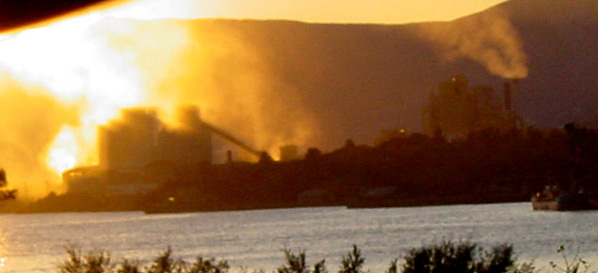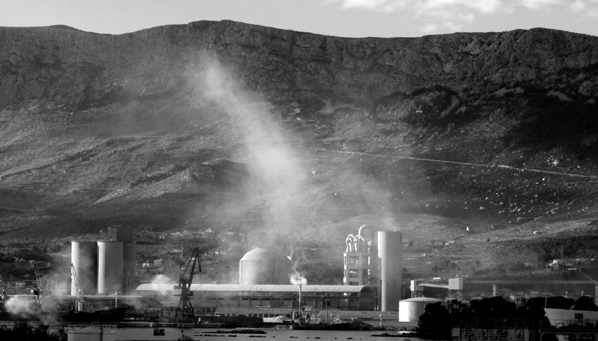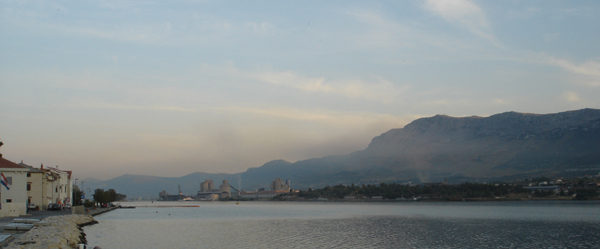The
Polluters
Three
Croatian environmental NGOs (from Split, Kastela and Solin)
called the press conference on 22.01.2003. to alert the public
that Dalmacijacement-Readymix (now CEMEX)
company is changing their kiln technology in order to introduce
coal and petrol-coke as a fuel (as opposed to less harmful
oil). The company director announced the coal burning as introduction
to the waste burning which is to include hazardous waste.
Waste burning in cement kilns which will be enabled by the
newly introduced technology.
An
year after the press conference the company started with coal
burning. The result is multiplied increase in emissions of
previously released harmful and toxic matter, as well as introduction
of a series of new, extremely toxic and carcinogenic materials
- although the company claims they do not burn the waste yet.
The
another aim of the press conference was to inform media and
public that Croatian government in September 2002 passed a
decree allowing industry in Croatia:
1.
To multiply emissions of harmful and toxic matter into air
2. To exceed these newly set limits - up to three times until
31. December 2008 3. Not to make any measurements of the pollution
emissions until 1. July 2004.
In
another words the Croatian government allowed:
1.
Indefinite pollution since Sept. 2002 till July 2004, 2. three
times higher pollution of the nominal values until the beginning
of 2009 and 3. after that incomparably greater pollution with
respect to pollution allowed before this decree.
This
kind of incentive and tolerance for pollutants that Croatian
government exhibits is probably without the precedence around
the world. These careless and harmful decisions suggest the
high level of corruption in the government. The decree was
made in 2002 but government following that one did not change
anything with respect to this.
Probably
the most harmful decision passed in this decree is that cement
plants become at the same time waste burning facilities. It
is outrageous that just prior to this decree a petition was
signed by more than 10 000 people in the area around ?Dalmacijacement?
against this. In this petition citizens required from Croatian
government to stop yet another ecological tragedy caused by
?Dalmacijacement? that had 50 year record of the worst eco
incidents in the area. This time the company deliberately
plotted out the pollution with coal and waste.
When
waste, communal or hazardous is burned the emissions include
a series of heavy metals (like mercury, cadmium, lead, arsenic
and thallium) as well as palette of other toxic and carcinogenic
matters. Of these the most poisonous are dioxins and furans
which are some of the most toxic compounds known). They cause
genetic mutations and serious harm in the tissue of people
of all ages. They are extremely carcinogenic, cause aggressive
behavior, psychological abnormalities and destroy the immune
system of organisms. Dioxins accumulate in alive organisms
and they get eliminated only through the breast feeding. Children
being breast fed that way drink mother?s milk enriched with
dioxins and can be exposed to the level of dioxins 10-20 times
higher than adults. Babies that are exposed to dioxins before
the birth are 100 times more susceptible to their harmful
influence than adults.
When
waste is burned in cement kilns, poisons and carcinogenic
matters that do not get released into surrounding stay in
the cement itself and later on are literally built in into
houses and apartments. RMC group does not care about that
because market for their products are primarily Croatia and
Bosnia and Herzegovina. The decree of Croatian government
according to which cements plants become also the waste burning
facilities, opens the possibility of burning hazardous and
chemical waste camouflaged as petrol-coke or if needed even
without the camouflage (as announced by Vinko Janjak, DC-RMC
director from Slobodna Dalmacija 29.11.2000: ?we could burn
also waste oils (sic!!).
In
addition, this opens the possibility of bringing in the hazardous
waste from other countries like Great Britain to Croatia.
As the management of the company says on their own, RMC company
which is the owner of ?Dalmacijacement? through the joint
company ?Hales Waste Control? is ?one of the greatest waste
managers and disposers in the Great Britain?
Although
from time to time from Dalmacijacement they claim they are
not interested for waste burning (S.D. 27. 12. 2000.) this
?not-interestedness? had been demanted in the media several
times. By Vinko Janjak himself, for example who is the director
of the Dalmacijacement-RMC who said ?Waste burning in the
factory would not be a problem at all?we could burn plastic,
cardboard, paper?waste oils?
This
has been confirmed by the Croatian ministry of environmental
protection because they were told by the management of DC
that waste burning is ?one of their first three priorities?.
Because
of all these reasons, we request from Croatian ministry of
environmental protection
1.
to invalidate the decree by which they allow usage of coal
in DC
1. to invalidate the decree by which they allow cement plants
to burn waste and in which they also allow incomparably greater
emissions of harmful and toxic elements and compounds for
industry.
3.
We also demand of the Croatian government to finally begin
respecting the law related to waste so that valuable materials
from the waste would be recycled and not burned.
The
request signed up by: Enviromental protection organization
Sunce from Split, Lijepa naša Kaštela from Kaštela and Život
from Solina, with supppotrt of organizations: Živa Zemlja,
Zagreb; ZELENI OSIJEK, Osijek; KOMPOST, Osijek; and Inicijativni
odbor, Koromačno. |





